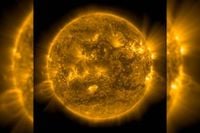On April 16, 2025, Earth will be enveloped by a significant magnetic storm, triggered by solar flares that occurred earlier this month. According to Mikhail Leus, a leading forecaster at the Phobos Weather Center, the peak of these magnetic storms, categorized at levels G1-G2, is expected to manifest during the latter half of the day.
The origin of this impending storm lies in two large solar protuberances that were ejected from the Sun on April 13, 2025. These protuberances, which are massive strands of dense gas, are known to have a profound impact on Earth's magnetosphere, making them a primary cause of substantial magnetic storms. As noted by the Laboratory of Solar Astronomy at IKI and ISZF, the solar material is anticipated to reach our planet during the night of April 16, leading to geomagnetic disturbances lasting nearly a full day.
Leus reported that there is a 70% probability of magnetic storms occurring on this date. He stated, "Solar substance, according to calculations, will come to Earth on the night of April 16. The total duration of geomagnetic disturbances will be about a day." Following this event, the intensity of the disturbances is expected to diminish by Thursday, April 17.
For those sensitive to weather changes, particularly during magnetic storms, experts recommend several health precautions. Individuals are advised to maintain proper hydration, increase their intake of vitamins, engage in moderate physical activity, and take regular walks outdoors. These steps can help mitigate the potential adverse effects that magnetic storms can have on health.
As the storm approaches, it is crucial to understand the potential impact on human health. Experts warn that approximately 75% of the Earth's population may experience negative effects during such storms. Common symptoms include headaches, fluctuations in blood pressure, dizziness, rapid heartbeat, and sleep disturbances. Some individuals may even experience joint pain and general discomfort.
On the evening of April 15, geomagnetic fluctuations are expected to reach four points on a nine-point scale, indicating a noticeable level of disturbance even before the main storm hits. The index for the storm itself is projected at six points, just one step away from being classified as a severe storm. Scientists are closely monitoring solar activity, as recent flares have released a colossal amount of energy directed towards Earth, contributing to the storm's intensity.
In light of these events, the Laboratory of Solar Astronomy has also highlighted the potential for stunning atmospheric displays, such as the aurora borealis, if the plasma clouds reach Earth as predicted. They noted, "The configuration of the interplanetary magnetic field is currently favorable for auroras. Preliminary predictions show some of the highest probabilities in recent months for auroras on the nights of April 15-16 and April 16-17, depending on the arrival time of the solar material."
Looking ahead, additional magnetic storms are forecasted for April 22 and April 24, with disturbances expected in the magnetosphere on April 17, 18, 21, and 25. This pattern suggests that the coming weeks could see a series of geomagnetic events, prompting ongoing vigilance from both meteorologists and the public.
With the storm's arrival imminent, individuals are encouraged to take proactive measures to protect their health and well-being. Experts emphasize that maintaining a healthy lifestyle, including a balanced diet and adequate sleep, can be beneficial during these periods of heightened geomagnetic activity. As one neurologist explained, human bodies react to magnetic fluctuations akin to a biocomputer, which can lead to a range of symptoms such as increased heart rate, blood pressure changes, insomnia, and migraines.
In summary, the magnetic storm set to impact Earth on April 16, 2025, serves as a reminder of the intricate connections between solar activity and life on our planet. As scientists continue to study these phenomena, the public is urged to stay informed and prepared for the potential impacts of such natural events.








